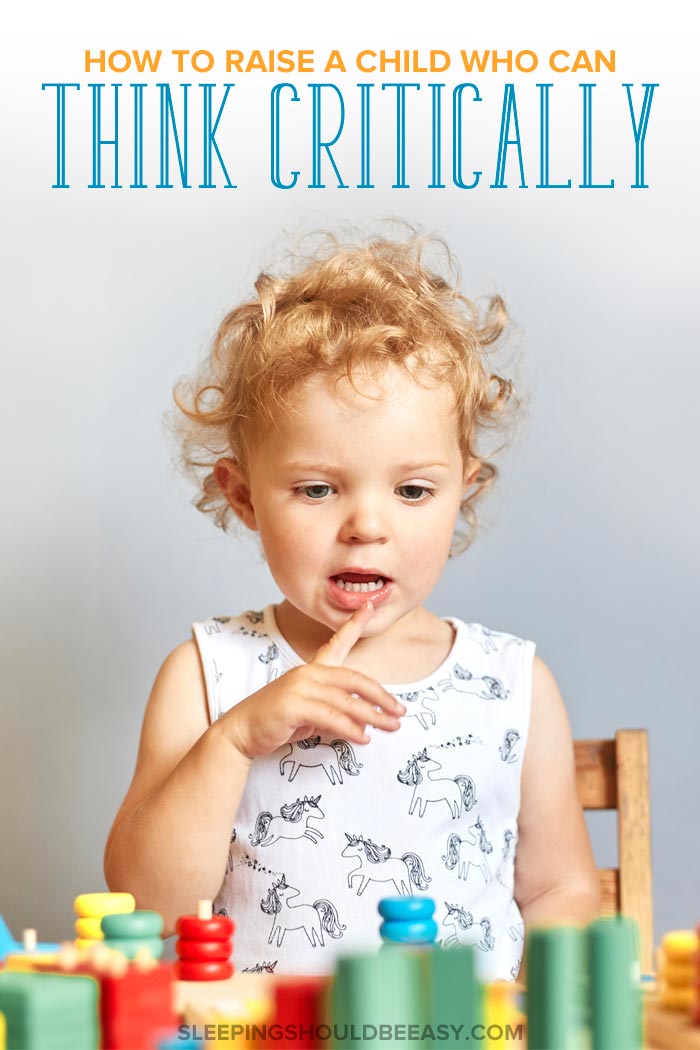How to Raise a Child Who Can Think Critically
Raising children who can think for themselves is important. Learn effective strategies to raise a child who can think critically.
 I was shocked—my son scoffed at me to leave him alone.
I was shocked—my son scoffed at me to leave him alone.
He had been playing with a drawing tool—a spirograph set—but at one point, I heard heavy sighs and mutterings under his breath. I chimed in with, “What’s up?”
“I can’t put these two pieces together,” he admitted. “I’m trying to make a design but they don’t fit.”
“Oh yeah, that looks tricky. Here—let me show you how to do it,” I offered.
And right away he responded, “No! Thanks, but I don’t want you to help.”
We mean well. We assume we’re doing our job as parents when we help our kids solve problems and save them from challenging emotions. But we undermine their abilities when we step in too often and too soon. Instead, we should see these difficulties as a chance for them to think for themselves, even at a young age.
After all, they need critical thinking skills to succeed. It’s not enough to memorize lessons or have their path laid out in front of them.
So, how can we raise a critical thinker who can solve problems and make a difference in the world? These tips can help you do just that:
Table of Contents
Allow your child to come up with solutions
The ultimate goal is for our kids to be able to think for themselves, even without our help. Sure, we can guide them along the way, but not to the point where we provide all the answers.
So, the first strategy to encourage critical thinking is to allow them to come up with their own solutions instead of always providing one for them.
I tried this approach when my twins were fighting. One of them approached me complaining about his brother.
Me: “How is he bothering you?”
Son: “He’s following and copying.”
Me: “Why do you think he’s doing that?”
Son: “He wants my toy.”
Me: “What can you do about it?”
Son: “Walk away.”
He was able to come up with a solution—”walk away”—on his own.
Trust me, this can be hard. I could’ve stepped right in and told the other one to leave his brother alone. I might have separated them or found another toy to distract them. I had to fight the urge to resolve their argument and spend extra time coaxing a solution out of my son.
But it was worth it. They were able to find a solution with a lot of questions and having an open mind.
Free email challenge: Join my newsletter and sign up for the Better Parenting 5-Day Challenge! We’ll tackle one tip per day that you can do right away. This is your chance to challenge yourself and make the changes you’ve been meaning to make:
Ask “how,” “why,” and “what” questions
Conversation starters for kids is a great way to help them think critically. We can do that by asking “how,” “why,” and “what” questions.
Let’s say your child told you that she saw a hummingbird near the flowers. Sure, you could say, “Wow—that’s cool!” or even “When did you see that?” But either response, though supportive, doesn’t dig into further thinking.
But what if you asked, “Wow—why do you think the hummingbird goes to our flowers?” Now she can create her own theories and viewpoints, maybe even drawing on past inferences she heard or read in a book.
And you don’t need to correct her if her answer is wrong (she’ll learn those facts in time). She might say, “The hummingbird is making a home.” Instead, keep drawing more theories out of her: “What could the hummingbird be using to make a home?”
Keep the questions going as far as they naturally flow and she’ll learn to stay curious about everything.
Respect your child’s questions
Do you respect your children’s questions? You may not mean to, but certain questions may elicit strange looks or reactions from you. Maybe household stress or work don’t give you the time or patience to answer them.
I’ll be the first to admit that I still have to catch myself in how I respond to my kids’ questions, no matter how bizarre or nonsensical they might be. They’ve asked questions in all earnest about things that seemed like odd questions to ask.
But if we look at the question, we realize how deep and inquisitive children truly can be at this young age.
Respect your child’s question the next time he asks. Don’t brush it off or give fluff answers to keep him quiet. Give it your best shot to answer questions, and suggest looking up an answer if you don’t know (yay, internet!). And make him feel like he can ask questions without judgment.
Don’t say “good question”
Sometimes I can’t stop myself from saying “good,” from “Good job!” to “Great question!”
On the surface, praising your child’s question as “good” makes sense: you want her to feel good for asking, and praise her for being so inquisitive.
But here’s the problem with labeling a question as “good”: You’re adding unnecessary judgment.
When we think about judgment, we imagine negative comments. But judgment also applies to positive phrases and enthusiasm, including calling something a “good question.”
Why? We’re implying that these certain questions are the ones they should keep asking. And that if there are “good” questions, then there must be “bad” ones to avoid as well.
Instead, honor all questions, whether strange or magnificent, silly or profound. If something catches you off-guard, encourage conversation and say, “That’s interesting.” Ask her what she thinks.
In treating all questions as valid, you’re encouraging her to keep asking, all without making her wonder if it’s worth asking or not.
Admit your own curiosity
“How do bees make honey?” my son asked me one day.
“You know, I have no idea,” I replied. “When we get home, let’s look it up and see how they do that.”
How bees make honey is just one of the many questions I had no idea how to answer (now I do after looking it up!). I don’t exactly know how many moons each planet has, and only know a handful of our states’ capitals.
The thing is, we don’t know all the answers, and we do a dishonesty to our kids in making it seem like we do.
Instead, they should see us stumped or curious about the same questions they wonder about. They’ll feel better knowing these are questions you’re willing to ask and learn about as well.
And most importantly, they’ll know that learning is a never-ending practice. We don’t reach a particular age or graduate from school having learned everything. For lifelong learners, there are always new discoveries to question and learn about, even as an adult.
Encourage “thinking words”
How often do we use threats, orders, and commands to get our kids to do things? If you’re like me, it can be often.
“Come here and brush your teeth now.”
“Eat your breakfast!”
“Stop jumping on the floor—it’s too noisy for the neighbors!”
And it’s normal—these are natural reactions to behaviors that make little sense to us. We know better than to waste time brushing our teeth, so we get frustrated and bark orders to get them to comply. And sometimes it feels like harsh words are the only things that can get through them.
But instead of forcing or threatening, set limits using thinking words. These are questions or statements to get your child to think about his behaviors, and then make the right choices.
For instance, instead of ordering him to finish eating breakfast, you can say, “Your brother and I are reading a book together. Feel free to join us once you’ve eaten breakfast.”
Or instead of barking orders to clean up, you might offer choices. “Your toys are still all over the floor. Would you like to keep playing another thirty minutes, or would you like to clean up now and start watching your show?”
These statements and questions prompt him to think about the results of his actions instead of following your orders.
Don’t make your child’s problem yours
We’re so aware of everything our kids are doing that we assume their problems are ours. We don’t allow them to own their problems and, more importantly, the lessons they can learn from them.
Let’s say your child isn’t doing his homework. As frustrating as it is to see him make poor choices and slack off, in the end, this is his problem, not yours. Instead of nagging him to finish his work, let him face his teacher and the consequences that will happen.
How do you know whether to get involved or not? Only do so when his problem becomes yours. Let’s say he’s not getting himself ready as quickly in the morning as you’d like him to, which means that not only is he late for school, but you’re late for work as well.
Now his morning routine has crossed over and becomes your problem. In this situation, you should intervene, because his choices affect you. Otherwise, if his choices only affect him, let the consequences do the teaching.
Offer choices
Parents are often encouraged to offer choices as a way to handle their children’s temper. After all, choices empower and give them some of the control they feel they’ve lost.
Another benefit? Choices also force them to think. You give your child options, and she has to think about them before making a decision. This encourages her to practice weighing her options instead of following her parents’ orders.
Choices are yet another opportunity to make and learn from mistakes. If you don’t “save” her from every mistake, these choices give her a chance to fail.
As odd as that sounds, it’s actually a good thing! You want her to practice making choices and experiencing the consequences now (even bad ones) when the stakes aren’t so high, compared to the stakes in high school and beyond.
Don’t punish
Disclosure: This article contains affiliate links. As an Amazon Associate, I earn from qualifying purchases.
This is perhaps one of the most misunderstood parts of parenthood. We assume handling kids means teaching lessons through punishment… except it doesn’t work.
This doesn’t mean you’ll be permissive during power struggles—you’re still holding your child accountable for his choices. But rather than punishment, allow the natural consequences to teach the lesson.
If he refuses to hang clothes in the closet, don’t take away his favorite toy. Instead, leave the clothes in the hamper. When he comes to you wondering where his dinosaur shirt is, point to the hamper. This becomes even clearer when you compare it to the world adults live in:
“The real world operates on consequences. If we do a consistently lousy job at work, our boss doesn’t take away our VCR—he fires us.” – Parenting with Love & Logic
I love that. Our kids learn best from consequences, not punishment.
Relying on punishment means that all that happens for not hanging his clothes is a parent getting angry and having a toy taken away.
He won’t learn the value of hanging his clothes to begin with. He isn’t able to think about his actions or choices. And he doesn’t know the value of changing his behavior. Instead, he directs his anger toward the punisher (you).
Conclusion
At first, I wondered if these tips would frustrate my kids. I figured their goal was to solve a complex problem, regardless of who solved it or how. I also assumed they’d get annoyed with me peppering them with question after question.
But I learned that they actually enjoyed this kind of interaction. They preferred that I didn’t undermine their abilities by solving their problems. If they wanted me to step in, they’d let me know, like asking directly, “Can you help me?”
And I also realized they liked the extra attention I was showing when I’d ask these “thinking” questions. The conversations never dragged, either—the back-and-forth would always peter out on its own naturally.
Best of all, they seemed to enjoy drawing their own conclusions, and that I had encouraged them to do so.
Now I know better than to take my kids’ heavy sighs and mutterings as a sign to step in and solve the problem. All they needed was some time, encouragement, and the ability to think on their own.
Get more tips:
- 8 Life Skills Kids Need in Adulthood
- How to Raise a Bright Child
- 5 Mistakes Parents Make When Giving Kids Choices
Don’t forget: Join my newsletter and sign up for the Better Parenting 5-Day Challenge today—at no cost to you:


